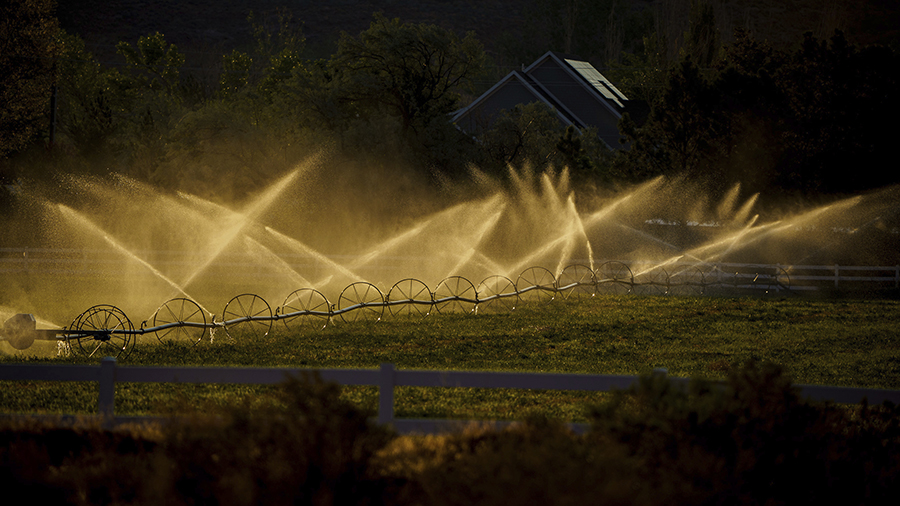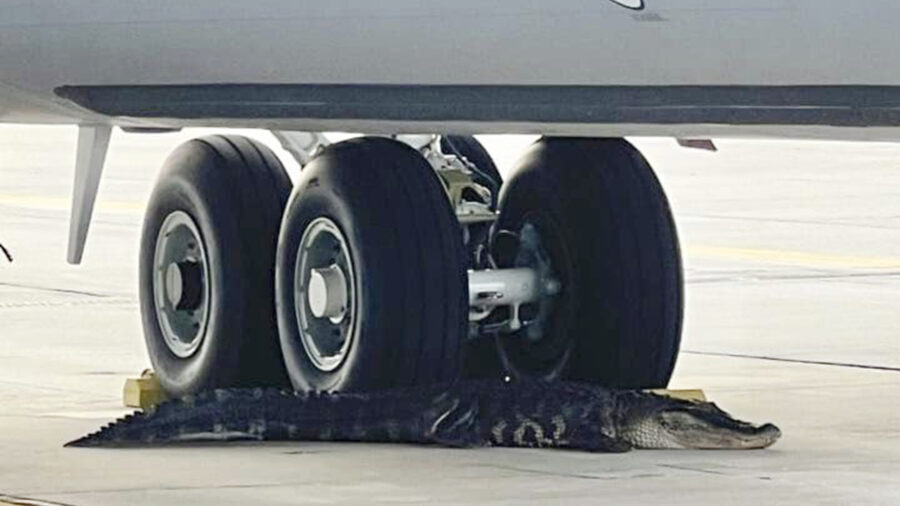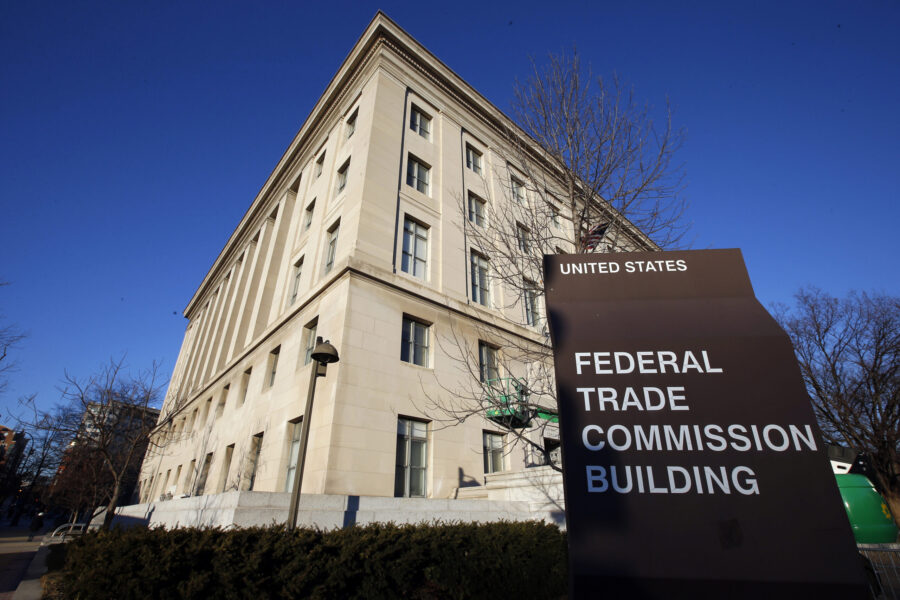Desert farms in Utah flourish with water from shrinking Colorado River
Sep 17, 2022, 8:08 AM | Updated: 2:08 pm

Crops are irrigated in Moab, Utah, Thursday, July 15, 2021. Compared to major cities neighboring states, Utah is less dependent on water from the Colorado River. (Trent Nelson/The Salt Lake Tribune via AP)
(Trent Nelson/The Salt Lake Tribune via AP)
SALT LAKE CITY, Utah (AP) — The second driest state in the country, Utah, doesn’t contribute much water to the Colorado River as it flows from Rocky Mountain headwaters through Canyonlands National Park to Lake Powell.
Utah has a unique position in the middle of the river basin, geographically and politically, and it wields less influence than thirstier and more populous states like Colorado, California and Arizona.
Its sprawling urban centers along the Wasatch Front, which are home to 80% of the state’s population, are outside of the Colorado River Basin and are less dependent on the river than cities like Phoenix or Las Vegas. Only 27% of the water used in Utah comes from the Colorado River, with the majority of the state’s water supply coming from other rivers that feed into the Great Salt Lake.
The Colorado river supports 42 million people directly – the current situation which is due to get even worse next year isn’t a “challenge” for engineers – it’s a regional extinction event. pic.twitter.com/OblWqLwS15
— Peter Dynes (@PGDynes) September 14, 2022
___
EDITOR’S NOTE: This is part of a collaborative series on the Colorado River as the 100th anniversary of the historic Colorado River Compact approaches. The Associated Press, The Colorado Sun, The Albuquerque Journal, The Salt Lake Tribune, The Arizona Daily Star and The Nevada Independent are working together to explore the pressures on the river in 2022.
___
Under a 1948 agreement, Utah is entitled to 23% of the water used by the four states in the upper Colorado River Basin — receiving less water than Colorado but more than either Wyoming or New Mexico — and it typically uses around 1 million acre-feet of water from the Colorado annually.
For decades, Utah has sought to develop diversions from the river by pursuing projects like the controversial Lake Powell pipeline, which would transport 86,000 acre-feet of water from the reservoir to St. George and surrounding areas. But the state’s use has remained relatively static since 1994 despite its fast-growing population.
Insightful Colorado River compact humor in today’s Boulder Daily Camera. pic.twitter.com/N1U8rGMljg
— Peter Mayer (@mayer_water) September 14, 2022
Twenty-two years of drought in the basin have caused the Bureau of Reclamation to put more pressure on Utah and the six other Colorado River states to reduce use and abandon development plans, however, and the states are gearing up for renegotiations of water use guidelines that expire in 2026.
Utah’s designated representative in the discussions, Colorado River Commissioner of Utah Gene Shawcroft, said the drought has made planning difficult.
“It’s hard to look out four or five years if you can’t see past next spring,” Shawcroft said. “Part of our challenge all along has been to really focus on the renegotiations when we’re faced with such a critical day-to-day situation.”
Shawcroft said Utah is committed to planning for 2026 while also participating in more immediate water negotiations such as the Bureau of Reclamation’s call for water users across the basin to reduce use by as much as 30% next year to stabilize rapidly depleting levels in lakes Powell and Mead.
About 40 million people in the Western United States depend on water from the Colorado River, and the entire nation benefits from food farmed with its waters. https://t.co/BnRuG1DAAs pic.twitter.com/2TVyCEZGO1
— AP Climate (@AP_Climate) September 12, 2022
Utah is aggressively pursuing conservation measures through a broad suite of state legislation passed this year, Shawcroft added, including a law that allows farmers to forgo irrigation without losing their water rights. But he said bringing the system back into balance will likely require the biggest cuts to come from the largest water users in downstream states.
Jack Schmidt, director of the Center for Colorado River Studies at Utah State University, said that since 2001 agriculture has used over two-thirds of the Colorado River water in Utah. An additional 15% is pumped out of the basin, primarily to supply the Wasatch Front.
Over 300,000 acres of land in the state are irrigated with Colorado River water, mostly to grow forage crops to feed livestock like alfalfa.
“In light of the fact that 70% of the total Colorado River water is used by (agriculture),” Schmidt said, “it’s hard to imagine that agriculture won’t be taking the most significant cuts.”
But reductions in water use don’t necessarily have to hurt farmers’ bank accounts. “Agriculture very well might be fairly compensated for fallowing its fields,” he said.
Kayaking on the Colorado river today… does it get any better than this? ☀️🚣🏻♀️ pic.twitter.com/Nn2usnQnTg
— Dr. Alecia Cousins (@AleciaLCousins) September 16, 2022
Environmental groups like the Utah Rivers Council have pointed to Utah’s residential water use — the highest in the basin, per capita — and low water rates as evidence that more conservation in that sector is possible and needed.
The potential retirement of coal plants in Utah in the next decade, which use 6% of the Colorado River water, could also free up some supply for conservation or other uses.
Another consideration is tribal water rights in Utah, which must be satisfied through the state’s share of Colorado River water.
A court decree has recognized the Ute Indian Tribe’s right to 144,000 acre-feet of water, but the tribe may receive far more water if it settles its water rights claims with the state and the federal government.
The Utah portion of the Navajo Nation settled its water rights in May and has a recognized right to 81,500 acre-feet.
Navajo Nation President Jonathan Nez said his administration’s priority is to supply the thousands of Navajo homes in Utah that still lack running water, but he said the tribe might consider leasing the remainder of its water to other users.
“If we’re going to be sitting on paper water, as they say,” Nez said, “and we’re not able to use it, we might as well lease it to those that are in need.”
All of these factors will likely have a role to play as the basin states renegotiate guidelines before 2026.
Utah’s goals in the upcoming discussions, according to Shawcroft, will be to push for greater adaptability while working to ensure that states share water surpluses or cuts equitably as availability changes.
“I think we need to be resilient across a wide range of flows,” he said, “whether they be lower … or higher.”













